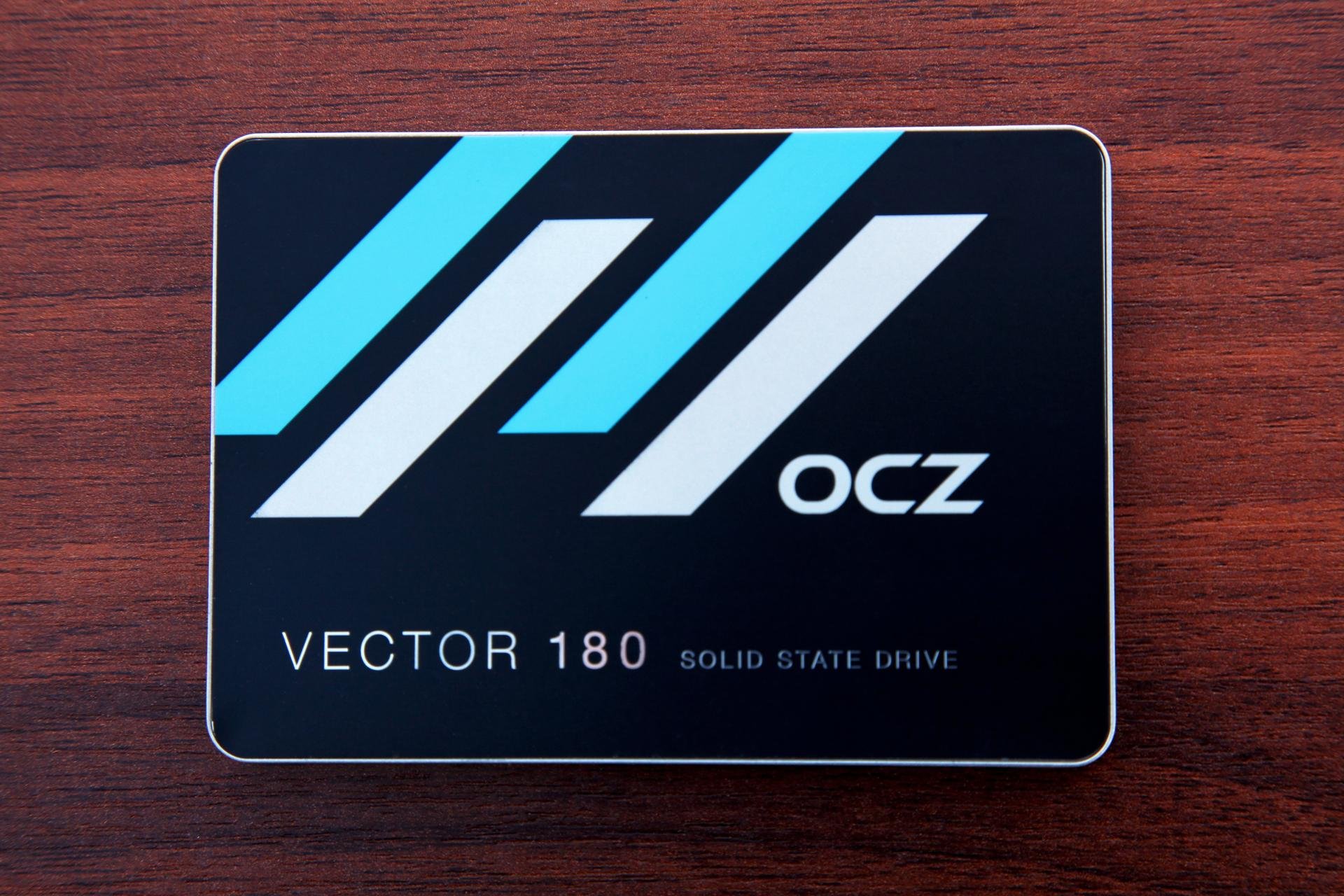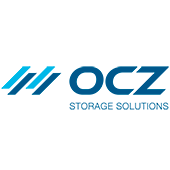Introduction
Today, there is nothing common about our torture subject. No, ladies and gentlemen. Today we have a drive of noble ancestry which will have to work hard to fill the shoes of its predecessor.
OCZ, in the course of renewing its consumer SSD line, is replacing the successful Vector 150 with the new OCZ Vector 180.
So, what is it with all the naked cables, the lightning and general mayhem in the image? Just a marketing stunt?
No, definitely not! They are related to a new function of the OCZ Vector 180 which sets it apart from its predecessor. And what would that be, you might ask. Yeah, right, like I would tell you everything in the introduction!
So, let us begin with the torture, because as the saying goes, when the going is tough, good SSDs get going! Or something to that effect.
And first of all, Anatomy 101!
From the packaging to the Silicon - What you get
The packaging of the OCZ Vector 180 is the standard OCZ, illustration paper box, protected by nylon, which we removed so you can see the box better in the picture.
- The "box"; Are you drunk? There's two of them!
All right, all right, I am not (very) drunk! There are indeed two boxes as OCZ sent us two different capacities of the OCZ Vector 180 to test for you. So, just for you, the readers of TheLab.gr, today's review will include the generous capacity of 480GB and the even more generous capacity of 960GB!
Going on with the packaging, the front is minimalistic and elegant, with a picture of the drive and its model, while a sticker on the lower right declares the capacity.
The back is more exuberant and includes information about the basic specifications of the drive and the performance of the various capacities. It also includes its certifications, two stickers with the model, the serial number and bar-codes as well as the claim, in 12 languages, that the OCZ Vector 180 can replace advantageously conventional Hard Disk Drives.
Excellent packaging, you might say, but lets move on to the juicy stuff! OK, at once!
Opening the packaging, we find the drive protected in a case of hard see-through plastic, as it is the norm of OCZ and with it an assortment of accessories worthy of its noble ancestry. That includes a 2,5" to 3,5" adapter, screws, a comprehensive installation manual in many languages and two leaflets, one of which includes instructions to download and install Acronis True Image 2013 as well as the required activation code.
You thought I forgot the second leaflet, right?
WEll, here it is, from both sides! This leaflet gets special attention as it is about the warranty of the OCZ Vector 180 which starts with this leaflet prompting you in 11 languages to not return the drive to the retailer, in case of malfunction, but to contact OCZ directly. You will find out why in the next page of this review.
Let us set aside for now the nice accessories and the papers and cut to the chase! Minimalistic and beautiful are two words befitting the OCZ Vector 180, with the top being common for all capacities.
The sticker on the bottom has information as the model, the product code, the serial number, certifications, the country where the drive was made(Taiwan), the firmware it comes with, as well as the voltage and current it requires.
The four screws in the corners are the ones we obviously have to remove to gain access to the interior of the drive. One of them is covered by a sticker warning of warranty loss if it is removed. There goes the sticker, there goes the warranty with it and with a simple Philips screwdriver we remove the four screws.
Four more screws keep the PCB of the OCZ Vector 180 firmly attached to the top of the chassis and a thermal pad connects the controller of the drive to the cover we just removed, ensuring cooling for the controller.
We remove these screws as well and gain access to the other side of the PCBs.
Please take note that in all pictures of both drives, on the left we have the OCZ Vector 180 480GB and on the right the OCZ Vector 180 960GB.
Under the thermal pad, on both drives, lies the well known Indilinx Barefoot 3 M00, marked IDX500M00-BC. It is the exact same controller we find in the στον Vector 150 and AMD R7, which is made by OCZ and it runs at 397MHz.
The cache memory for the controller is a chip by Micron on each side of the PCB, so we get two chips for the OCZ Vector 180 460GB and another two for the OCZ Vector 180 960GB.
These chips even though they come from different batches, as declared by the first number on them, are of the same type, specifications and capacity, as declared by the second number on them. They are the Micron D9QBJ which are DDR3 1600Mhz CL11 chips with a capacity of 4Mbit, that is to say 512ΜΒ each. This means that each drive sporting two of these chips, has 1GB of cache memory, the exact same of the 480GB Vector 150.
Where the two drives differ, is the capacity of their NAND chips. As you have seen, each drive has 16 NAND chips, 8 on each side of the PCB. The difference is that the OCZ Vector 180 480GB has Toshiba TH58TEG8DDKBA8C A19 256Gbit NAND chips while the OCZ Vector 180 960GB has Toshiba TH58TFG9DFKBA8K A19 512GBit NAND chips.
Let us do some math, so you can confirm that I am completely sober.
On the 480GB drive, we have: 16 x 256Gbit = 16 x 32GB = 512GB total. The drive offers 480GB to the user, so the missing 32GB, one of the 16 NAND chips ή or 6,25% of total capacity is reserved for the over provisioning of the drive.
On the 960GB drive, we have: 16 x 512Gbit = 16 x 64GB = 1024GB total. The drive offers 960GB to the user, so the missing 64GB, one of the 16 NAND chips ή or 6,25% of total capacity is reserved for the over provisioning of the drive.
And last, we see the part of the PCB containing a big orange SMD part. It is a capacitor, with a large, for PCB standards, capacitance, which is related to the new function of the OCZ Vector 180. Are you thinking lightning and general mayhem? Be patient! You will soon know!
The observant among you will have noticed that on the right PCB, the one from the OCZ Vector 180 960GB there is a Voltage Step Down chip and a coil missing. It is because this capacity of the drive does not need them.
After mentioning the excellent quality we observed , let us proceed to the next page to find out what all these parts can do!
Specifications - What is this thing capable of?
What could anyone do to improve on the already excellent specifications of the OCZ Vector 150? Certainly not much as it is already pushing the limits of the SATA 6GB/s protocol. Then what are the improvements that justify replacing it with a new model?
As you can see in the following table, the OCZ Vector 180 brings a new capacity not available with its predecessor, 960GB. It also replaces the Toshiba 19nm NAND chips with the newer Toshiba A19 NAND chips which, albeit slightly slower, they are cheaper raising expectations for more competitive end products. The 5 year warranty remains but it is upgraded to ShieldPlus, which we will elaborate on in the next page. Finally, there is an added function, called Power Failure Management Plus!
So, that is what all the lightnings and mayhem was about. Now, what it is and what it does exactly, you will see in the next page.
Let us start the specifications of the OCZ Vector 180 with a table showing the performance of its various available capacities. Note that the best performing model is the 480GB which is the largest capacity using 256GBit NAND chips, while the 960GB model, using 512GBit NAND chips, comes second.
In this table we see the reliability features of the OCZ Vector 180. And first of all the encryption features which are 256-bit AES-compliant and support only ATA passwords while the industry is turning to the safer and easier to use TCG Opal encryption. Be that as it may, desktop users will be fine with it.
Continuing down the table, we see the ECC error correction of the OCZ Vector 180, the support of S.M.A.R.T. and the fact that the drive is rated for 50GB of writes per day for 5 years.
Here we can see the physical characteristics and parts of the OCZ Vector 180, which we saw in detail in the previous page.
Here we see the power consumption of the [OCZ Vector 180 and the high tolerances it has to environmental factors, as all SSDs do.
It is noteworthy that the OCZ Vector 180 sadly does not feature low power states (slumber and DevSleep), so its power consumption in idle state is comparatively higher than the competition.
In the next table, we have the MSRPs for the various capacities of the OCZ Vector 180. Notice that the recent aggressive pricing policy of OCZ is also applied to the OCZ Vector 180. The price per GB is highly tempting for such a premium drive, especially as capacities rise.
Following is the placement of the OCZ Vector 180 in the OCZ consumer SSD product line. You can also see the most important specifications of the various models and their cost.
And last, a table comparing the specifications and cost of the OCZ Vector 180 to that of some of its major competitors. The price of the OCZ Vector 180 is the MSRP, as it is not out in the shops yet, while the prices of the competing products are from newegg.com on 2/2/2015.
Let us now proceed to the next page to answer any questions that may have risen regarding the special features of the OCZ Vector 180.
Power Failure Management Plus & ShieldPlus Warranty - What the others do not have
Let us see at last what exactly is this Power Failure Management Plus (PFM+). As you can see in the following diagram, thanks to special routines in the firmware but also to that big orange capacitor we saw, the OCZ Vector 180 can protect itself and your data from power abnormalities or even total power loss.
We have to clarify that, as mentioned in the diagram, the protection covers the resting data and not the in flight data.
An excellent feature, that is truly worth the trouble of creating a new model. But it is reasonable to ask, could such a feature, requiring constant and periodic checks, have an impact on performance?
The answer is yes. And no.
As you can see on the screenshot of the AIDA 64 Average Write Access, there is one and only one but fairly large latency spike during the testing of the OCZ Vector 180 960GB. A similar latency spike, but on a smaller scale, is found of the test of the OCZ Vector 180 480GB. This latency spike is not particularly noticeable, but it is measurable and as you will see in the tests we will subject the two OCZ Vector 180s, it can in some cases cause delays.
This is the price the OCZ Vector 180 has to pay in order to provide the important extra safety of the PFM+. Let us also not forget that the drive is still using its first version of firmware and it is possible that the effect could diminish in the future with a firmware update.
Let us now address the other point where the OCZ Vector 180 has the edge over its predecessor which is no other than the warranty.
OCZ is launching a new kind of warranty in the SSD market which promises to make users' lives easier. According to this new warranty which OCZ calls ShieldPlus, you no longer need any proof of purchase for the RMA procedure as the serial number of the product is enough. But this is not even the best part. In case of the product malfunctioning and after you contact OCZ and start the RMA procedure, a new SSD is forwarded to the consumer by the company. After the consumer receives the new drive he sends the malfunctioning one back to the company at OCZ's expense.
All we can say is a big well done to OCZ for the warranty of the OCZ Vector 180 and that we wish other companies would follow the same path. Such a warranty cannot but point out the great confidence OCZ has on the quality of its product.
Speaking of which, OCZ has finally released the official figures on drive failures in recent years and we can see that from 2010 to 2014 there was an incredible increase in drive reliability which seems to be due to the cooperation of OCZ with Toshiba and the usage of the latter's NAND chips.
So, these are the extra features of the OCZ Vector 180! Let us now go and see the Software OCZ offers with it.
Software - Complete and Renewed
Along with the OCZ Vector 180, OCZ is releasing their new software, SSD Guru.
The software includes all the functions you will need to perform on you SSD Drive. We will display and explain its capabilities.
When you first run the software you will see the screen above and in the horizontal menu the first tab "Overview" will be selected. On the upper left of the tab, there is a drop down menu where you can select any OCZ drive available in your system. Non-OCZ Drives will not appear.
Choosing a drive, we can see its picture below as well as the Model and Serial Number.
Below that, we can see the four sub-tabs with the first, "Dashboard", already chosen.
On the right there is a bigger windows with five modules. In the module "Capacity" we can see the capacity of the drive as well as details on how much of it is free and how much is used. In the drop down menu we can choose if the statistics apply to the whole of the drive or just one of its partitions.
In the module "Interface" we can see the interface protocol, which idealy is SATA III (6GB/s) and if the AHCI is enabled. The color of the dots change from green to orange or red acordingly to the severity of the non-ideal situation, which generally happens on various parts of all the modules and is explained by clicking the round "?" button in each module.
The round "?" button in each module explains their functions in detail as well as the various color codes they may employ.
The module "Health" shows the Health of the drive and the color denotes if the drive is in good health (green) , needs to be monitored for future replacement (orange) or needs to be immediately replaced (red).
The module "Updates" shows the firmware of the drive and reports if it is up to date.
If the drive has a temperature sensor, as in the case of the OCZ Vector 180, there is one more module, "Temperature" which provides a graphical display of the drive's temperature.
In the sub-tab "SSD Details" we can see details for the chosen SSD drive.
In the sub-tab "System Details" we can see details for our whole system.
In the sub-tab "SMART" we can see in a clear and easy to understand way, some of the S.M.A.R.T. details of the drive.
We continue with the other tabs.
The second tab of SSD Guru is "Tuner" and has only one sub-tab, "SSD Tuner".
This includes two modules, "Trim", where you can give a manual Trim command, and "Over Provisioning" where you can assign more Over Provisioning space. And we say "more" as all OCZ drives already have 6,25% of their space assigned to Over Provisioning, which you cannot remove from this module but you can add more.
The third tab of SSD Guru is"Maintenance" and has only one sub-tab, "Tools".
This includes two modules, "Firmware Update" where from the drop down menu you can choose to upgrade the firmware through the internet, if there is a newer firmware for the chosen drive, or from a file on our local disk, and the module "Secure Erase" where we can give a secure erase command to restore the drive to its original factory state.
The fourth tab of SSD Guru is "Settings" and includes only one sub-tab, "Settings".
This includes three modules. The first, "Logging" provides the ability to activate and deactivate the logs of SSD Guru. The second module, "Monitoring", includes to options to load the SSD Guru with Windows as well as to keep it running in the system tray when you close the GUI. The last module in the tab is "Proxy server" which gives us the ability to assign a proxy server for the communication of the SSD Guru with the internet.
The fifth and last tab of the SSD Guru is "Help" and includes only one sub-tab, "Help".
This includes two modules. The first is "Contact OCZ" and includes links to the support of OCZ as well as its Forums. The second module is "Save support package" where we can create a file with the required data to send to the support of OCZ. This is very convenient, especially to the less experienced users.
On the whole, we can say that SSD Guru can simply and easily perform all the functions needed by an SSD User. The only thing missing, is an interactive guide to improve Windows setting for use with an SSD Drive.
Test System and Methodology - Let's see, what are we using and how
Our test system is based on the Asrock Z97X Killer. This particular motherboard sports SATA III, SATA Express and Μ.2. interfaces making it able to support all SSDs in the market, currently and in the near future. Thus it provides the means to make direct comparisons on the same system.
The CPU is the Intel G3258 Anniversary Edition, with unlocked multiplier which allowed us to easily overclock it to 4,5 GHz. Keeping in mind that the SSD test with high IOPS require hick clocks but run on only one thread, this particular CPU is perfect for our tests.
The RAM is at 8GB which more than covers our needs for the tests, The PSU is the V650 by Cooler Master and the system is housed by the Cooler Master Test Bench V1.0.
Our warmest thanks toAsrock and Cooler Master for the parts they provided for the construction of our test system!
The operating system on which we run our tests is Windows 7 64bit and it includes, aside of all the drivers, the basic programs that come with the motherboard so we can achieve a more realistic and close to fact test environment. The driver of the SATA controller used was the Intel 13.10.1058, obviously in AHCI mode.
The tests which the two OCZ Vector 180s will undergo are divided into 4 categories:
1: Synthetic benchmarks on an empty drive, where the tested SSD is a secondary drive to the test system, empty and relaxed. These are the perfect conditions you will never see in real usage.
2: Synthetic benchmarks on a system drive, where the operating system is installed in the tested SSD. Here things come a little closer to reality, but synthetic benchmarks are still synthetic.
3: Steady State Benchmarks where we measure the performance of the SSD while it writes random data for a prolonged period of time so it reaches its worst possible performance. Here things are the opposite of before and thus very unfavorable and unlikely to appear during the usual home usage. But they are the rule in database and file servers.
4: Real Life Tests! Here, using the special suite created for us by the programmer Stelios Sifakis (whom we thank!), we perform some of the most usual tasks and time them. In these tests we place the most gravity for the score as they show the real experience a user will have.
The SSDs included in our comparison are the AMD R7 240GB, the Corsair Force LX 256GB, the Kingston SSDNow KC300 240G, the Kingston SSDNow V310 960GB, the OCZ ARC 100 240GB, the Samsung 840 EVO 250GB, the top performing Samsung 850 Pro 256GB and of course, our leading actors, the OCZ Vector 180 960GB and OCZ Vector 180 480GB.
At this point we would like to note the following. Due to the special nature of the OCZ Vector 180 and because of the PFM+, in some runs of certain tests that happened to coincide with a latency spike, we got abnormally low readings. These readings were rejected and not taken into account in the mean values, because to properly incorporate them to the statistical analysis we would have to run each test thousands of times, which is not possible. So you should know that the mean values you will see in the charts do not include the effects of the latency spikes, except if noted otherwise.
Stay tuned. After the tests there is commentary and score!
Synthetic Benchmarks in an Empty Drive - We start easy
We start with the HD Tune Pro 5.50 which measures the reading and writing IOPS in unpartitioned SSDs. Lets see how the OCZ Vector 180 fares against its competitors:
In the read tests the OCZ Vector 180 is the best in both tested capacities, while the 480GB model seems to have even more IOPS than the 960GB one.
The write tests gave similar results.
We continue with the Average Access tests of AIDA 64 4.50. With the AIDA 64 Average Read Access and Average Write Access, executed in a drive without partitions we see the response time of the SSD to various requests. In other words, we measure its latency. Here, lower is better.
In the Average Read Access test, the OCZ Vector 180 performs admirably and in among the fastest drives.
In the Average Write Access test the performance is also great, but we also see the one and only one latency spike which is larger and more noticeable in the 960GB model.
Following is the AS SSD Benchmark, version 1.7.4739.38088.
In the read tests OCZ Vector 180 is exceptional, right on the heels of the top performing Samsung 850 Pro 256GB.
But in the write tests it takes the lead, even by a small margin, as both OCZ Vector 180 models showed exemplary performance.
In the copy tests, which are a mixture of read and write, the performance of the OCZ Vector 180 was also among the best.
Following are the tests of the CrystalDiskMark 3.03b x64.
In this test we also measure excellent performance for the OCZ Vector 180 as it is only slower than the two Samsung drives, while...
on the write tests it ties with the Samsung 850 Pro 256GB and the AMD R7 240GB for the first place.
Moving on to the score from the Anvils Storage Utilities 1.1.0.
In this test the OCZ Vector 180 is also slower than the two Samsung drives, mainly due to differences in performance in the Read tests.
We now come to the suites of Futuremark whom we older guys remember as MadOnion. These suites try to simulate real working conditions. Lets start with the PCMark 05.
Here OCZ Vector 180 holds its own in all tests but the Virus Scan which is the known Achilles heel of all OCZ drives we have tested to date.
Going on to the more contemporary PCMark7.
Nothing but good results for the OCZ Vector 180 which is second only to the Samsung 850 Pro 256GB. We also see a difference between the two capacities of the OCZ Vector 180 in the "Starting Apps" test, where the OCZ Vector 180 480GB is faster than the 960GB version.
And we conclude this series of tests with the most recent PCMark8, where the results are in seconds and lower is better.
Here we have nothing special to notice, except the good performance of the OCZ Vector 180 480GB in the "Photoshop Heavy" test.
Good results for the new nobility of OCZ. Let us proceed to the next page and take things up a notch.
Synthetic Benchmarks on a System Drive - Things are getting interesting
We spice things up a bit, running the same benchmarks but this time the operating system is installed on the SSD tested.
Once again we start with the HDTune Pro 5.50 but this time obviously on a partitioned drive and we only run the read test as the write test is destructive and would have erased all data on the drive.
The existence of the operating system on the drive, limited the performance of all tested drives, but in doing so, it also gave the OCZ Vector 180 a bigger lead over its competitors. This drive seems to be having excellent response times.
We continue with the Random Read Access of AIDA64 4.50, on a partitioned drive now. The Random Write Access, being destructive, is omitted.
And we confirm our previous findings as the OCZ Vector 180 has unbelievably low latencies!
Going on to the AS SSD Benchmark version 1.7.4739.38088, where there is nothing to tell, as the results are on par with the ones we saw in the previous page where the OCZ Vector 180 did not have an operating system installed on it.
Following are the tests of the CrystalDiskMark 3.03b x64, where the same thing happens.
Continuing with the Anvils Storage Utilities 1.1.0, on which we see no notable difference from the test without the O.S.
Following are the tests of Futuremark.
In all the tests of PCMark05, PCMark7 and PCMark8 the results are similar to the ones on the empty drives. If you don't believe us, here they are:
And we finish with BootTimer which measures the time from the loading of the windows kernel until the desktop is usable.
Both models perform similar to each other and the AMD R7 240GB, slightly behind the Samsung 850 Pro 256GB and the Corsair Force LX 256GB.
Similar results to the previous page for the OCZ Vector 180 that is steadily in the higher ranks of the synthetic benchmark results.
Let us now hit the tough road!
IOMeter Steady State Tests - We press it, can it take it?
The next test is purely sadistic. We make the SSD write random 4K packages for 12 hours straight without resting and measure its IOPS every five minutes. After some time and as the garbage collection and trim features do not have time to work, the SSD reaches a steady state where every write has to preceded by a deletion of the NAND cell and the SSD operates at its worst performance.
This case is very unlikely to occur in light, casual usage but it is the norm in database and file servers. You should consider the following results according to the heaviness of your workload .
OCZ takes pride in the performance of its SSDs in this particular test and the OCZ Vector 180 is no exception. The Steady State IOPS of the OCZ Vector 180 are among the best and near them are only other OCZ models.
Moreover, due to the large capacities of our samples, they can maintain their top performance for longer before the curve starts to drop, something you can clearly see on the left part of the chart.
observing the following diagram, where we see the last two hours of the Steady State Test, we see that the OCZ Vector 180 480GB holds at slightly above 22000 IOPS in Steady State, just shy of its 23000 IOPS specification and the AMD R7 240GB which exceeded its 20000 IOPS specification.
The OCZ Vector 180 960GB on the other hand falls to 18200 IOPS, significantly lower than its specification which is 20000 IOPS and even less than the entry level ARC 100 240GB which exceeded its 18000 IOPS specification.
It is the first time we see an SSD by OCZ not living up to their Steady State IOPS Specifications and we do not know if it is due to the newer and cheaper but also slightly slower NAND chips, the PFM+ feature or that they are still on their first firmware, but in any case the Steady State IOPS of these drives are still far better than the competition. We remind you that the OCZ Vector 150 480GB has a 26000 IOPS specification in Steady State.
Following is the mixed workload test. SSDs in a system rarely do 100% reads or 100%% writes like in the synthetic benchmarks. In the following test we start with three five-minute tests of 100% random reads and keep the average. We continue with three five-minute tests of 95% random reads and 5% random writes and keep the average and so forth as indicated in the graph until we get to 100% random writes. Note that this particular test is run on a drive that has already reached steady state and tries to simulate heavy multitasking.
Here, as was expected, the OCZ Vector 180 480GB marginally bests the AMD R7 240GB while the OCZ Vector 180 960GB fares similarly to the OCZ ARC 100 240GB.
Finishing these very hard tests, we have to stress that it is a very rare occasion to find such extreme conditions in normal everyday use. Their value is to show us the other side of the synthetic benchmark coin and let us try to find the truth somewhere in the middle.
But instead of guessing we have a better suggestion. The suite of Real World Tests is coming to clear the field, with true tasks in windows and exact timing.
Real Life Tests - How is it in real life?
We start with the windows startup time test. One might ask, didn't we already do that with BootTimer? As we said, BootTimer measures the time from the loading of the windows kernel until the desktop is usable. But windows itself records in the event viewer the total time of the windows start up, until all services are loaded. As reason indicates, this time is significantly longer.
In Starting Windows the two OCZ Vector 180 achieved the second and third best times, after the Kingston KC300 240GB that had managed a truly unbelievable time.
We continue with real file copying.
We copy 32000 4K files, 500 MP3s, 1000 21MP JPGs, a 7,52GB ISO 7.52GB and a 10GB High Definition MKV movie. The respective times are shown in the diagram below with the OCZ Vector 180 having slightly better times than the AMD R7 240GB in the first three tests but slightly worse in the bug file copying tests. There, it seems that the latency spike issue is effecting the results. On the whole, the file copying times are exceptional.
Next, we will store a folder containing the setup of the Office 2013 in a rar file (using the "store" setting), where the OCZ Vector 180 has the best time of all the drives and...
...then we will decompress a - compressed - rar containing the setup folder of Office 2013, making, again, the best time.
We continue with a virus scan of the system32 folder of windows using the Avira Antivirus, where the drives by OCZ traditionally do not do well. We see that the OCZ Vector 180 has less of a problem, but it still isn't as fast as some of the competitors.
Next we will open a 324MP TIF file with Photoshop CS6 save it as BMP and close Photoshop. In this test the OCZ Vector 180 480GB and the OCZ Vector 180 960GB share third place, right behind the drives from Samsung, but with negligible difference.
Then we open Word 2013, load a huge DOCX with images links etc, save it as DOC and close Word.
Here the OCZ Vector 180 960GB achieved the best time with the OCZ Vector 180 480GB slightly behind, but the differences between all drives are small to negligible.
Next, we install MS Office 2013, where the latency spikes again make their presence known and are unavoidable as a single run lasts more than three minutes. As a result we see the not so great performance of the two OCZ Vector 180 in this test, especially the 960GB model. We have to mention that we in fact saw even slower times in some runs of the particular test, which we could not incorporate in the mean value we use in the chart, for statistical reasons.
Thus, and with the significant influence of this last test, the total time of the Real Life Tests is as follows:
Not at all bad, as the OCZ Vector 180 480GB got the second place, behind the unbeatable Samsung 850 Pro 256GB, while the OCZ Vector 180 960GB got the fourth place, due to the larger latency spikes.
It is certain that the OCZ Vector 180 is not an easy drive to review. How does one evaluate the all the positives and some negatives we saw?
Lets proceed to the last page to sum it all up.
Conclusions and Score - To the point
Life is full of surprises and delicate balances. The new nobility of OCZ surprised and troubled us and now we have to find the balance.
It is a drive with exceptional build quality, a renowned controller, a lot of cache, and tested, very good NAND chips.
It also incorporates the innovative, for a consumer SSD, PFM+ feature that protects the drive and your stored data from a catastrophic power loss but also has its price in the form of latency spikes.
In the same time, it offers the wonderful new warranty by OCZ, the ShieldPlus, according to which any drive replacement that is needed during the warranty period will be done at your home, with simple and quick procedures.
As far as Features go, the OCZ Vector 180 loses the top mark of 10 by just a little because its controller does not support TCG/Opal encryption and the low power state DevSleep.
In Performance, we will be even more harsh and deduct points for the subtle but sometimes noticeable latency spikes and for the fact that we could not achieve the specified Steady State IOPS. Here the OCZ Vector 180 960GB loses more points than the OCZ Vector 180 480GB as the larger capacity model has larger and more noticeable latency spikes.
Regarding the price, we do not have a specific street price, as the drive has not hit the stores yet, but if you take a look at the MSRPs in page three of this review (all those who skipped to the end, can now go back), they are just great for a drive of this class. And as the capacity rises, the price per GB gets even better. Thus, in price, the OCZ Vector 180 960GB covers the ground it lost to the OCZ Vector 180 480GB in performance.
Thus, we will have a common score for both OCZ Vector 180 capacities we tested.
Lets sum up the advantages and disadvantages of the OCZ Vector 180:
Advantages
+ Very good results in all Benchmarks
+ Very good results in the Steady State Tests
+ Very good results in the Real Life Tests
+ Power Failure Management Plus (PFM+) feature
+ 5 year ShieldPlus warranty
+ Specifications for 50GB / day for 5 years
+ Support for TRIM and Garbage Collection
+ Support for AES 256 encryption
+ Complete and functional Software
Μειονεκτήματα
- Latency Spikes
- Lower than specified Steady State IOPS
- No support for TCG/Opal
- No support for DevSleep
Based on all of the above, the final score of the OCZ Vector 180 is:
Our thanks to OCZ for supplying the review samples
Polymeros Achaniotis 24/03/2015
-
 3
3
































Recommended Comments
There are no comments to display.
Create an account or sign in to comment
You need to be a member in order to leave a comment
Create an account
Sign up for a new account in our community. It's easy!
Register a new accountSign in
Already have an account? Sign in here.
Sign In Now